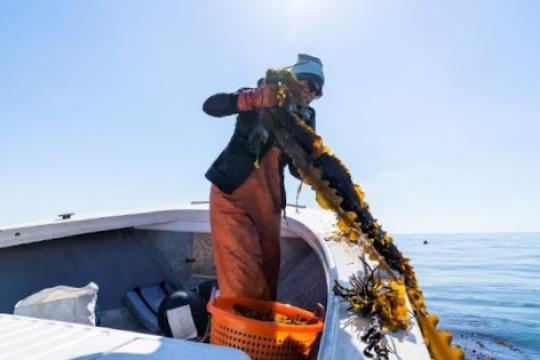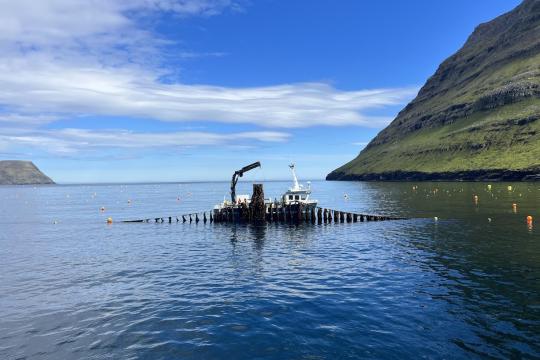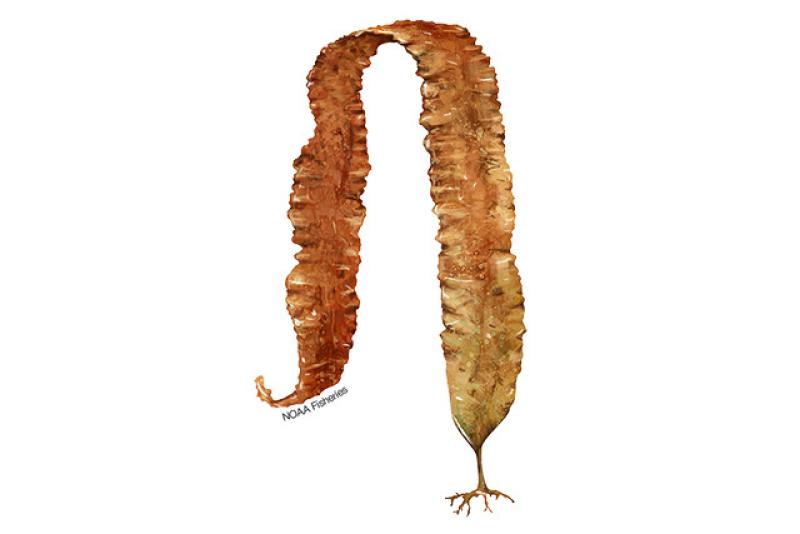 Fisherman pulling up sugar kelp. Credit: GreenWave/Ron Gautreau
Fisherman pulling up sugar kelp. Credit: GreenWave/Ron Gautreau
Fisherman pulling up sugar kelp. Credit: GreenWave/Ron Gautreau
About the Species
 Fisherman pulling up sugar kelp. Credit: GreenWave/Ron Gautreau
Fisherman pulling up sugar kelp. Credit: GreenWave/Ron Gautreau
Fisherman pulling up sugar kelp. Credit: GreenWave/Ron Gautreau
Sugar kelp is a yellowish brown marine algae widely cultivated and eaten in Asia and growing in popularity in the United States as a nutritious food high in fiber, vitamins, and minerals. Sugar kelp has long been known as a sweetener and as having thickening and gelling qualities that can be added to food and cosmetics. Sugar kelp is being grown and harvested by more commercial farms for a variety of uses, from food to potential biofuels.
Appearance
- Sugar kelp are yellowish or dark-brown and green in color.
- They resemble large lasagna noodles and have a long narrow, undivided blade with a short thin stem.
- The central band of the blade is dimpled while the margins are smoother with a wavy edge. The crinkled blade gives the sugar kelp its other common names.
Biology
- Sugar kelp reach maturity between 3 and 4 years of age.
- Their blade can grow up to 5 meters (16 feet) long and 20 centimeters (7.9 inches) wide.
- Sugar kelp can live for 2 to 4 years and grow quickly in colder months.
Scientific Classification
| Kingdom | Protista | Phylum | Ochrophyta | Class | Phaeophyceae | Order | Laminariales | Family | Laminariaceae | Genus | Saccharina | Species | latissima |
|---|
Last updated by NOAA Fisheries on 04/25/2025
Featured News
 Suzie Flores harvesting sugar kelp in Stonington, Connecticut (Credit: Elizabeth Ellenwood).
Suzie Flores harvesting sugar kelp in Stonington, Connecticut (Credit: Elizabeth Ellenwood).
 Oyster growers harvest farmed shellfish from the Damariscotta River in Maine. NOAA has awarded several grants to small businesses working to develop new tools to advance sustainable U.S. aquaculture. (Image credit: C. Katalinas/ Maine Sea Grant)
Oyster growers harvest farmed shellfish from the Damariscotta River in Maine. NOAA has awarded several grants to small businesses working to develop new tools to advance sustainable U.S. aquaculture. (Image credit: C. Katalinas/ Maine Sea Grant)

 Oysters being farmed by Alaska Shellfish Farms in Kachemak Bay, Alaska. Credit: NOAA Fisheries
Oysters being farmed by Alaska Shellfish Farms in Kachemak Bay, Alaska. Credit: NOAA Fisheries
Seafood Facts

Is Sugar Kelp Sustainable?
U.S. farmed sugar kelp is a smart seafood choice because it is grown and harvested under U.S. state and federal regulations.
Availability
Fresh product when harvested is available February to May, while dried kelp is available year round.
Source
Commercially farmed in cold water regions along the East and West Coast of the United States and Alaska.
Taste
Sugar kelp has a savory and slightly sweet flavor. When dried, a white, sweet-tasting powder forms on the blade.
Texture
Crunchy texture
Health Benefits
High in fiber, anti-oxidants, vitamins, and minerals.
Nutrition Facts
Servings: 1; Serving Weight: 100 g (raw); Calories: 43; Protein: 1.68 g; Total Fat: 0.56 g; Total Saturated Fatty Acids: 0 g; Carbohydrate: 9.57 g; Total Sugars: 0.60 g; Total Dietary Fiber: 1.3 g; Cholesterol: 0 g; Sodium: 233 mgMore Information
- Sustainable Seafood
- (Podcast) Seaweed: The Miracle Macroalgae with Major Economic and Environmental…
- Tide to Table Profiles: Atlantic Sea Farms
- Tide to Table Profile: Monterey Bay Seaweeds
- Tide to Table Profiles: Seagrove Kelp Co.
- (Video) Alaska Kelp Farming: A New Sustainable Seafood Opportunity
- Sign Up for "Taste of the Tides" Newsletter
Kelp Recipes
Looking for some ways to add kelp into your rotation? If you need some cooking inspiration, browse these recipes for sugar kelp miso soup, sugar kelp cookies, and more!

Last updated by NOAA Fisheries on 04/25/2025
Seafood News
 Celebrate Culinary Arts Month with a sustainable seafood recipe for every month of the year.
Celebrate Culinary Arts Month with a sustainable seafood recipe for every month of the year.
What Your Birth Month Says About Your Next Seafood Recipe
 Fresh-caught taʻape on ice. Credit: Conservation International Hawaiʻi.
Fresh-caught taʻape on ice. Credit: Conservation International Hawaiʻi.
Reducing Waste and Feeding Communities in Hawaiʻi with a Whole Fish Approach
 Chef Tyler Hadfield’s Curried Skate Wings with Tomato-Masala Chutney
Chef Tyler Hadfield’s Curried Skate Wings with Tomato-Masala Chutney
Ring In the New Year With These Crowd-Favorite Seafood Recipes
 NOAA Fisheries, in collaboration with Blue Ocean Mariculture, is conducting a multi-year pilot study to evaluate observational methods and tools for studying Hawaiian monk seal behavior. Courtesy of Blue Ocean Mariculture
NOAA Fisheries, in collaboration with Blue Ocean Mariculture, is conducting a multi-year pilot study to evaluate observational methods and tools for studying Hawaiian monk seal behavior. Courtesy of Blue Ocean Mariculture
AI Meets Aquaculture to Study Hawaiian Monk Seal Interactions With Net Pens
Last updated by NOAA Fisheries on 04/25/2025
Last updated by NOAA Fisheries on 04/25/2025
Aquaculture
U.S. farmed sugar kelp is a smart seafood choice because it is grown and harvested under U.S. state and federal regulations.

Environmental Impact
Sugar kelp provides net environmental benefits by removing excess nutrients and carbon dioxide and releasing oxygen to mitigate against ocean acidification.

Feeds
Growing sugar kelp requires no feed—sugar kelp produce their own food through photosynthesis, using sunlight, carbon dioxide, and water.

Farming Methods
Sugar kelp lines are seeded in a land-based nursery and then placed in tanks or marine waters for grow-out.

Human Health
Sugar kelp is high in fiber, vitamin C, vitamin K, iron, calcium, iodine, and magnesium.
Management
- Permitting for sugar kelp aquaculture is governed by federal, state, and local governments.
- The federal agencies involved are NOAA, the U.S. Army Corps of Engineers, U.S. Fish & Wildlife Service, U.S. Department of Agriculture, the Environmental Protection Agency, the Food and Drug Administration, and the U.S. Coast Guard.
- All fisheries and aquaculture farms in federal waters must adhere to federal regulations including those in the Magnuson-Stevens Fishery Conservation & Management Act, the Endangered Species Act, the National Environmental Policy Act, the Clean Water Act, and the Marine Mammal Protection Act.
Farming Methods
- Seed production:
- Wild sugar kelp is harvested to extract spores for culture.
- Spores are settled onto nylon twine wrapped around a PVC pipe (or spools).
- Once spores have settled after 24 to 36 hours, the spools are placed in indoor tanks under controlled conditions.
- After 4 to 6 weeks, the juvenile kelp plants are transferred to the grow-out site.
- Grow-out:
- The seed string with juvenile plants attached is deployed in tanks or on long lines (a heavier culture rope suspended between buoys) in marine waters.
- Sugar kelp is harvested when it reaches the appropriate size for its intended purpose.
Production
- Seaweed farming is just now establishing in the U.S. and shows promise to become an important contributor to future U.S. marine aquaculture production
Environmental Considerations
- Habitat:
- Sugar kelp farming has a benign ecological footprint, with little disturbance of sediments or aquatic vegetation during grow-out. It may cause some shading of the seafloor environment depending on the depth in which it is grown.
- Seeding is a quick process accomplished from small skiffs and harvesting is also quick and efficient consisting of bringing a long line onto the boat and removing the kelp with a small knife; both of these operations are low impact on the environment.
- Feeds:
- Once transferred to the ocean site, sugar kelp does not need to be fed due to photosynthesis.
Ecosystem Services
- Water quality improvements:
- Sugar kelp consume excess nutrients and carbon dioxide from the water column and give off oxygen as they grow, improving water quality of the surrounding environment.
- When sugar kelp is harvested, excess nutrients, such as nitrogen and phosphorus, as well as carbon dioxide are removed from the ecosystem.
- Providing habitat:
- Sugar kelp provides structure and shade for many marine organisms and serves as habitat for juvenile fish and small invertebrates.
- Sugar kelp beds also disperse wave energy to protect shorelines from erosion.
Human Health
- Sugar kelp toxins:
- Sugar kelp can assimilate toxins like heavy metals such as mercury present in the water where they are grown, but levels are extremely low making it safe at quantities typically consumed.
- Early warning systems exist to detect harmful algal blooms that produce toxins.
- New technologies, such as the Environmental Sample Processor, provide near real-time detection of harmful algal species.
- For more information on the prevention and monitoring of harmful algal blooms, read about NOAA's Harmful Algal Bloom forecasting program.
- Pathogenic bacteria:
- Bacteria like Vibrio and salmonella can be found in contaminated water where farmed sugar kelp may grow.
- Ingestion of sugar kelp contaminated with salmonella or other bacteria can lead to gastrointestinal illness.
- Sugar kelp is required to be tested for toxins and bacteria and public health officials monitor farmed sugar kelp to ensure it is safe to eat.
Last updated by NOAA Fisheries on 04/25/2025
Science Overview
- Ocean acidification:
- Acidification causes a number of changes in water chemistry that may be stressful to estuarine organisms.
- In 2015, the Puget Sound Restoration Fund, NOAA, and other partners received $1.5 million from the Paul G. Allen Family Foundation to tackle the impacts of ocean acidification using sugar kelp.
- Growth and genetics:
- The Northeast Fisheries Science Center’s Milford Lab is studying different aspects of sugar kelp to help commercial growers expand their operations.
- In early 2017, researchers tested the lab’s sorting flow cytometer. The instrument will allow high-volume screening of individual kelp plants for desired traits such as high-temperature tolerance. This method may be used in the future for improving sugar kelp strains.
- Human health:
- Milford Lab scientists, through a grant from the NOAA Aquaculture Program, are also studying different kinds of organisms like bacteria, micro-and macro-algae that may be growing on the surface of sugar kelp at different stages of the kelp’s growth. They isolated Vibrio bacteria from the plant to see how abundance changes throughout the growing season. They have found that Vibrio is absent during most of the growing season since this bacteria prefers warmer waters. This information can help growers harvest in the best possible conditions.
- Energy:
- One of the Milford Lab’s sugar kelp collaborators also received $5.7 million in 2017 from the Department of Energy through the agency’s program focused on advancing seaweed energy production, Macroalgae Research Inspiring Novel Energy Resources (MARINER). The grant to Woods Hole Oceanographic Institution will fund a selective breeding program for sugar kelp and an autonomous underwater observation system to advance the mass production of seaweed for biofuels and bio-based chemicals.
More Information
Last updated by NOAA Fisheries on 04/25/2025
Documents
NOAA Fisheries Alaska Fiscal Year 2022 Aquaculture Accomplishments
The Alaska Regional Office and Alaska Fisheries Science Center continue coordinated efforts to…
Last updated by NOAA Fisheries on 04/25/2025

